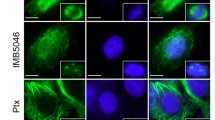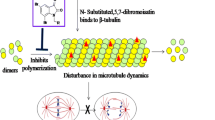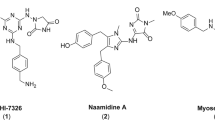ABSTRACT
Purpose
To evaluate abilities of 2-aryl-4-benzoyl-imidazoles (ABI) to overcome multidrug resistance (MDR), define their cellular target, and assess in vivo antimelanoma efficacy.
Methods
MDR cell lines that overexpressed P-glycoprotein, MDR-associated proteins, and breast cancer resistance protein were used to evaluate ABI ability to overcome MDR. Cell cycle analysis, molecular modeling, and microtubule imaging were used to define ABI cellular target. SHO mice bearing A375 human melanoma xenograft were used to evaluate ABI in vivo antitumor activity. B16-F10/C57BL mouse melanoma lung metastasis model was used to test ABI efficacy to inhibit tumor lung metastasis.
Results
ABIs showed similar potency to MDR cells compared to matching parent cells. ABIs were identified to target tubulin on the colchicine binding site. After 31 days of treatment, ABI-288 dosed at 25 mg/kg inhibited melanoma tumor growth by 69%; dacarbazine at 60 mg/kg inhibited growth by 52%. ABI-274 dosed at 25 mg/kg showed better lung metastasis inhibition than dacarbazine at 60 mg/kg.
Conclusions
This new class of antimitotic compounds can overcome several clinically important drug resistant mechanisms in vitro and are effective in inhibiting melanoma lung metastasis in vivo, supporting their further development.






Similar content being viewed by others
Abbreviations
- μM:
-
micromolar per liter
- ABI:
-
2-aryl-4-benzoyl-imidazole compounds
- BCRP:
-
breast cancer resistance protein
- DAMA-colchicine:
-
N-deacetyl-N-(2-mercaptoacetyl)-colchicine
- DMSO:
-
dimethyl sulphoxide
- DTIC:
-
dacarbazine
- FBS:
-
fetal bovine serum
- HMEC:
-
human microvascular endothelial cells
- MDR:
-
multidrug resistant
- MRP:
-
MDR associated proteins
- MTD:
-
maximum tolerable dose
- nM:
-
nanomolar per liter
- SAR:
-
structure-activity relationship
- SCID:
-
severe combined immunodeficiency
- SHO mice:
-
double homozygous SCID hairless outbreed mice
- SMART:
-
substituted methoxylbenzoyl-aryl-thiazole
- SPA:
-
scintillation proximity assay
- SRB:
-
sulforhodamine B
- TGI:
-
tumor growth inhibition
REFERENCES
Gray-Schopfer V, Wellbrock C, Marais R. Melanoma biology and new targeted therapy. Nature. 2007;445:851–7.
Serrone L, Zeuli M, Sega FM, Cognetti F. Dacarbazine-based chemotherapy for metastatic melanoma: thirty-year experience overview. J Exp Clin Cancer Res. 2000;19:21–34.
Mandara M, Nortilli R, Sava T, Cetto GL. Chemotherapy for metastatic melanoma. Expert Rev Anticancer Ther. 2006;6:121–30.
Li W, Lu Y, Wang Z, Dalton JT, Miller DD. Synthesis and antiproliferative activity of thiazolidine analogs for melanoma. Bioorg Med Chem Lett. 2007;17:4113–7.
Eggermontand AM, Robert C. New drugs in melanoma: it's a whole new world. Eur J Cancer. 2011;47:2150–7.
Kahlerand KC, Hauschild A. Treatment and side effect management of CTLA-4 antibody therapy in metastatic melanoma. J Dtsch Dermatol Ges. 2011;9:277–86.
Roukos DH. PLX4032 and melanoma: resistance, expectations and uncertainty. Expert Rev Anticancer Ther. 2011;11:325–8.
Lu Y, Li CM, Wang Z, Ross 2nd CR, Chen J, Dalton JT, Li W, Miller DD. Discovery of 4-substituted methoxybenzoyl-aryl-thiazole as novel anticancer agents: synthesis, biological evaluation, and structure-activity relationships. J Med Chem. 2009;52:1701–11.
Chen J, Wang Z, Li C-M, Lu Y, Vaddadya PK, Meibohma B, Dalton JT, Miller DD, Li W. Discovery of novel 2-aryl-4-benzoyl-imidazoles targeting the colchicines binding site in tubulin as potential anticancer agents. J Med Chem. 2010;53:7414–27.
Fox E, Maris JM, Widemann BC, Goodspeed W, Goodwin A, Kromplewski M, Fouts ME, Medina D, Cohn SL, Krivoshik A, Hagey AE, Adamson PC, Balis FM. A phase I study of ABT-751, an orally bioavailable tubulin inhibitor, administered daily for 21 days every 28 days in pediatric patients with solid tumors. Clin Cancer Res. 2008;14:1111–5.
Zhang F, Michaelson JE, Moshiach S, Sachs N, Zhao W, Sun Y, Sonnenberg A, Lahti JM, Huang H, Zhang XA. Tetraspanin CD151 maintains vascular stability by balancing the forces of cell adhesion and cytoskeletal tension. Blood. 2011;118:4274–84.
Ahn S, Hwang DJ, Barrett CM, Yang J, Duke 3rd CB, Miller DD, Dalton JT. A novel bis-indole destabilizes microtubules and displays potent in vitro and in vivo antitumor activity in prostate cancer. Cancer Chemother Pharmacol. 2011;67:293–304.
Wang Z, Lu Y, Seibel W, Miller DD, Li W. Identifying novel molecular structures for advanced melanoma by ligand-based virtual screening. J Chem Inf Model. 2009;49:1420–7.
Chen J, Smith M, Kolinsky K, Adames V, Mehta N, Fritzky L, Rashed M, Wheeldon E, Linn M, Higgins B. Antitumor activity of HER1/EGFR tyrosine kinase inhibitor erlotinib, alone and in combination with CPT-11 (irinotecan) in human colorectal cancer xenograft models. Cancer Chemother Pharmacol. 2007;59:651–9.
Bhattacharyya B, Panda D, Gupta S, Banerjee M. Anti-Mitotic Activity of Colchicine and the Structural Basis for Its Interaction with Tubulin. Medi Res Rev. 2008;28:155–83.
Zmijewski MA, Li W, Zjawiony JK, Sweatman TW, Chen J, Miller DD, Slominski AT. Photo-conversion of two epimers (20R and 20S) of pregna-5,7-diene-3beta, 17alpha, 20-triol and their bioactivity in melanoma cells. Steroids. 2009;74:218–28.
Bazaa A, Pasquier E, Defilles C, Limam I, Kessentini-Zouari R, Kallech-Ziri O, El Battari A, Braguer D, El Ayeb M, Marrakchi N, Luis J. MVL-PLA2, a snake venom phospholipase A2, inhibits angiogenesis through an increase in microtubule dynamics and disorganization of focal adhesions. PLoS One. 2010;5:e10124.
Tong YG, Zhang XW, Geng MY, Yue JM, Xin XL, Tian F, Shen X, Tong LJ, Li MH, Zhang C, Li WH, Lin LP, Ding J. Pseudolarix acid B, a new tubulin-binding agent, inhibits angiogenesis by interacting with a novel binding site on tubulin. Mol Pharmacol. 2006;69:1226–33.
Guo W, Wu S, Liu J, Fang B. Identification of a small molecule with synthetic lethality for K-ras and protein kinase C iota. Cancer Res. 2008;68:7403–8.
Gourdeau H, Leblond L, Hamelin B, Dong K, Ouellet F, Boudreau C, Custeau D, Richard A, Gilbert MJ, Jolivet J. Species differences in troxacitabine pharmacokinetics and pharmacodynamics: implications for clinical development. Clin Cancer Res. 2004;10:7692–702.
Povlsenand CO, Jacobsen GK. Chemotherapy of a human malignant melanoma transplanted in the nude mouse. Cancer Res. 1975;35:2790–6.
Xu L, Begum S, Hearn JD, Hynes RO. GPR56, an atypical G protein-coupled receptor, binds tissue transglutaminase, TG2, and inhibits melanoma tumor growth and metastasis. Proc Natl Acad Sci U S A. 2006;103:9023–8.
Ravelli RB, Gigant B, Curmi PA, Jourdain I, Lachkar S, Sobel A, Knossow M. Insight into tubulin regulation from a complex with colchicine and a stathmin-like domain. Nature. 2004;428:198–202.
Salmon SE. Human tumor clonogenic assays: growth conditions and applications. Cancer Genet Cytogenet. 1986;19:21–8.
Lau DH, Xue L, Young LJ, Burke PA, Cheung AT. Paclitaxel (Taxol): an inhibitor of angiogenesis in a highly vascularized transgenic breast cancer. Cancer Biother Radiopharm. 1999;14:31–6.
Stafford SJ, Schwimer J, Anthony CT, Thomson JL, Wang YZ, Woltering EA. Colchicine and 2-methoxyestradiol Inhibit Human Angiogenesis. J Surg Res. 2005;125:104–8.
Li CM, Lu Y, Narayanan R, Miller DD, Dalton JT. Drug metabolism and pharmacokinetics of 4-substituted methoxybenzoyl-aryl-thiazoles. Drug Metab Dispos. 2010;38:2032–9.
Kidera Y, Tsubaki M, Yamazoe Y, Shoji K, Nakamura H, Ogaki M, Satou T, Itoh T, Isozaki M, Kaneko J, Tanimori Y, Yanae M, Nishida S. Reduction of lung metastasis, cell invasion, and adhesion in mouse melanoma by statin-induced blockade of the Rho/Rho-associated coiled-coil-containing protein kinase pathway. J Exp Clin Cancer Res. 2010;29:127.
Lavelle F, Gueritte-Voegelein F, Guenard D. Taxotere: from yew's needles to clinical practice. Bull Cancer. 1993;80:326–38.
Nelson RL. The comparative clinical pharmacology and pharmacokinetics of vindesine, vincristine, and vinblastine in human patients with cancer. Med Pediatr Oncol. 1982;10:115–27.
Beerepoot LV, Radema SA, Witteveen EO, Thomas T, Wheeler C, Kempin S, Voest EE. Phase I clinical evaluation of weekly administration of the novel vascular-targeting agent, ZD6126, in patients with solid tumors. J Clin Oncol. 2006;24:1491–8.
Gottesman MM, Fojo T, Bates SE. Multidrug resistance in cancer: role of ATP-dependent transporters. Nat Rev Cancer. 2002;2:48–58.
Colone M, Calcabrini A, Toccacieli L, Bozzuto G, Stringaro A, Gentile M, Cianfriglia M, Ciervo A, Caraglia M, Budillon A, Meo G, Arancia G, Molinari A. The multidrug transporter P-glycoprotein: a mediator of melanoma invasion? J Invest Dermatol. 2008;128:957–71.
Berger W, Hauptmann E, Elbling L, Vetterlein M, Kokoschka EM, Micksche M. Possible role of the multidrug resistance-associated protein (MRP) in chemoresistance of human melanoma cells. Int J Cancer. 1997;71:108–15.
Diestra JE, Scheffer GL, Catala I, Maliepaard M, Schellens JH, Scheper RJ, Germa-Lluch JR, Izquierdo MA. Frequent expression of the multi-drug resistance-associated protein BCRP/MXR/ABCP/ABCG2 in human tumours detected by the BXP-21 monoclonal antibody in paraffin-embedded material. J Pathol. 2002;198:213–9.
Li CM, Wang Z, Lu Y, Ahn S, Narayanan R, Kearbey JD, Parke DN, Li W, Miller DD, Dalton JT. Biological activity of 4-substituted methoxybenzoyl-aryl-thiazole: an active microtubule inhibitor. Cancer Res. 2011;71:216–24.
Giacomini KM, Huang SM, Tweedie DJ, Benet LZ, Brouwer KL, Chu X, Dahlin A, Evers R, Fischer V, Hillgren KM, Hoffmaster KA, Ishikawa T, Keppler D, Kim RB, Lee CA, Niemi M, Polli JW, Sugiyama Y, Swaan PW, Ware JA, Wright SH, Yee SW, Zamek-Gliszczynski MJ, Zhang L. Membrane transporters in drug development. Nat Rev Drug Discov. 2010;9:215–36.
Ambudkar SV, Dey S, Hrycyna CA, Ramachandra M, Pastan I, Gottesman MM. Biochemical, cellular, and pharmacological aspects of the multidrug transporter. Annu Rev Pharmacol Toxicol. 1999;39:361–98.
Tahir SK, Kovar P, Rosenberg SH, Ng SC. Rapid colchicine competition-binding scintillation proximity assay using biotin-labeled tubulin. Biotechniques. 2000;29:156–60.
Nikolinakosand P, Heymach JV. The tyrosine kinase inhibitor cediranib for non-small cell lung cancer and other thoracic malignancies. J Thorac Oncol. 2008;3:S131–134.
ACKNOWLEDGMENTS & DISCLOSURES
This work was supported by the NIH/NCI Grant R01CA148706-01A1 to WL with additional partial support from GTx, Inc. (SA, CL and JTD). We thank Dr. Christina Barrett for her help in the colchicine site binding assay, Dr. Feng Zhang for capillary network formation assay, Dr. Bob M. Moore II and Dr. Steven Gurley for helping in taking microtubule images, and Dr. David Armbruster for editorial assistance.
Author information
Authors and Affiliations
Corresponding author
Electronic Supplementary Material
Below is the link to the electronic supplementary material.
ESM 1
(DOC 3444 kb)
Rights and permissions
About this article
Cite this article
Wang, Z., Chen, J., Wang, J. et al. Novel Tubulin Polymerization Inhibitors Overcome Multidrug Resistance and Reduce Melanoma Lung Metastasis. Pharm Res 29, 3040–3052 (2012). https://doi.org/10.1007/s11095-012-0726-4
Received:
Accepted:
Published:
Issue Date:
DOI: https://doi.org/10.1007/s11095-012-0726-4




